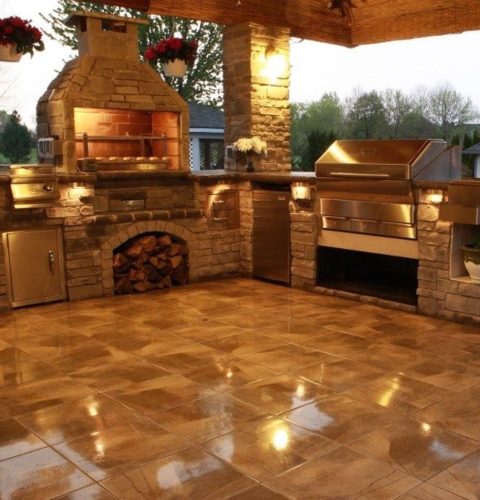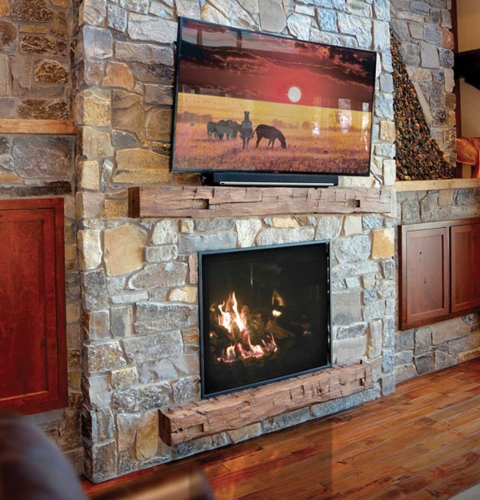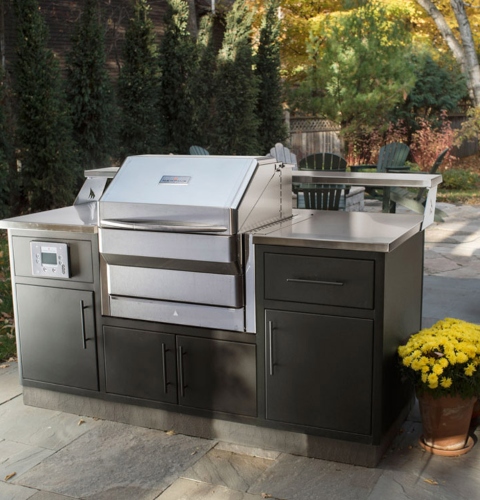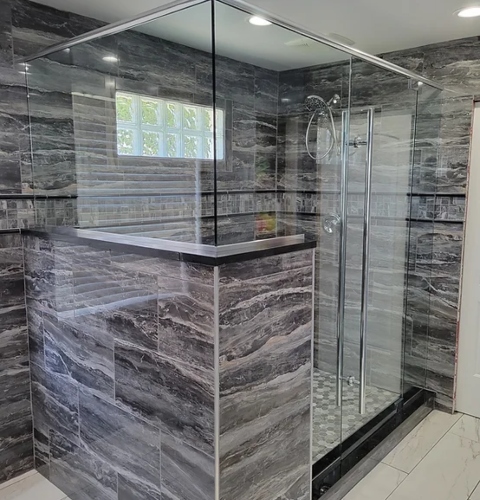Picks Gallery Services
If you’re fed up with the way a product looks or works in your home, but think it’s too big of a project to take on, you need to contact us.
We have been changing fireplaces, stoves, shower doors and complete rooms for years and have mastered making the process run as smoothly and efficiently as possible.
By using our in-house staff we can perform complete remodels that are too large for most homeowners, but too small for most contractors. By keeping the project in-house, we are able to control quality, scheduling and cost in order to provide an excellent result for you in the least amount of time, with the least amount of hassle.
Fireplace and Stove Service
Fireplace, stove and service on other fire-breathing appliances make up the majority of our calls. This area will hopefully help you solve some of the more common issues, without the need for a service call.
If your fire breather is acting up, simply choose the fuel type from the items on the right to get started.
Gas Products Service
No matter what type of gas appliance you have, it requires maintenance.
- What type of maintenance is required for a gas stove or fireplace?
- Very little normal maintenance is required. Homeowners should be able to clean the glass, and control compartment clear of dust and debris. Most people find it better for the more technical maintenance to be performed by a qualified service technician. Most manufacturers recommend that the gas connections, electrical components, and gas trains be serviced annually by a service technician. Typically, there are only a few wearable parts in today’s gas fireplaces and stoves. The logs, glass, burner, and other major parts are normally covered by long warranties and are designed to last the life of the appliance. Pilot assemblies contain wearable parts that need to be replaced every 3 – 10 years. This includes the thermocouple, thermopile, and/or Oxygen Depletion Sensor.
- The pilot light won’t light, or won’t stay lit.
- First, if you are using propane or LP, please go to the tank, lift the lid and confirm that you have fuel. There will be a gauge on the tank that tells you how full the tank is by percentage. Even if you just had your tank filled and you never use any gas – check. Mistakes and leaks happen, and we can’t do anything until you have gas. If you have gas, click here to learn about pilot issues.
- First, if you are using propane or LP, please go to the tank, lift the lid and confirm that you have fuel. There will be a gauge on the tank that tells you how full the tank is by percentage. Even if you just had your tank filled and you never use any gas – check. Mistakes and leaks happen, and we can’t do anything until you have gas. If you have gas, click here to learn about pilot issues.
- The burner won’t light or makes noise or messy black stuff when it does.
- These are usually service call issues, but there are a few things to check. Click here for burner issues.
- How do I clean the glass?
- If your gas fireplace or stove has a glass panel on the front, it normally can be removed with a few screws, or clamps holding it in place. Once removed, a high-quality gas fireplace glass cleaner should be used. Normal ammonia-type glass cleaners have been known to affect the finish of the glass, including putting a rainbow effect in it that cannot be removed.
- Your appliance is too hot, or not hot enough.
- This may be a service issue caused by gas pressure issues or installation issues, or it may just be the wrong type of appliance for you. We will assess these situations at no charge for any brand.
Wood Fireplace Support Center
- No, Dad, you should not clean your chimney by filling it with newspaper and lighting it.
- First, let’s dispel the myth that a wood fireplace or stove can cause back drafting or indoor smoking issues by itself. Most operational problems have little to do with the fireplace. The chimney is the engine of the fireplace or stove and therefore is the most important part to diagnose. If your stove or fireplace is back drafting there are many things that can cause it. Improper chimney planning, not necessarily installation, is the general root of all evil considerations. Today’s tightly built homes offer more challenges than ever when it comes to getting smoke to leave them. We have created a balloon we call home and try to take air and smoke out without letting any in. It causes issues. Finding out why your house isn’t letting the smoke out can be a daunting task, even for a National Fireplace Institute Certified Wood Specialist, but ours have the experience to handle it. Call us for an appointment with one of them to fix your house.
- Wood.
- It sounds simple, and it is if you know all the rules. Seasoned cordwood is the only wood that should be used in today’s new EPA-approved stoves and fireplaces, but it seems that few people know what ‘seasoned’ means. Seasoned means cut and split and stored in such a manner that air can circulate through the wood while protecting it from precipitation. A tree, cut down and laying on the ground, will not dry out. The bark and rings of a tree are designed specifically not to let moisture out. Until you fix that, you can’t expect the tree to start to dry.
- General Maintenance
- Your fireplace or stove will require maintenance beyond filling it with wood and lighting. Your chimney should be cleaned annually by a certified chimney sweep. Depending on your stove or burning habits, you may need periodic cleaning throughout the season as well. Our stoves, burned correctly, should only need annual cleaning. Every time you clean your chimney, you should also inspect the firebox, gaskets, glass and latches for wear.
- Following three key rules will enable you to help keep your chimney clean longer between cleanings.
- First, burn only seasoned wood. Burning wet or green wood takes a huge amount of heat, which could have been used in your home, to evaporate the water before the wood can burn. This is why it burns longer in non-EPA-approved appliances, but it is not helpful or efficient. Remember – you would never add water to the gas in your car ‘to make it last longer.’
- Second, burn it hot. Small hot fires burn more effectively and efficiently than large smoldering fires. If you plan to burn your stove for a long period of time on low, then start with a 30 – 45 minute period of burning on high, to get the chimney warm, get a large amount of fuel into the charcoal stage faster, and burn the gases and residues that would otherwise cling to your chimney.
- Lastly, before you even buy a stove and chimney system, make sure to get the best one your budget can afford. Definitely use an insulated chimney when possible over an air-cooled chimney. Insulated chimneys keep flue gases hotter and help to create a better draft. Air-cooled chimneys can cause draft problems in cold climates by taking longer to warm up and being harder to keep warm.
The tip that makes you glad you read all the way to the bottom of the page:
- How to clean your fireplace glass without the use of harsh chemical cleaners.
- Take a damp cloth and dip it into the very fine white ash in your firebox. Rub this ash on the glass. Repeat as needed until the glass is like new. Buff ashes off with a clean towel. This also polishes metal extremely well, like your favorite brass Zippo lighter that you use to light your stove.
Electric Fireplace Support Center
Just like your VCR that has been flashing 12:00 since the early 90s, if it plugs in and has buttons – there are issues.
There are just a few main difficulties people have using electric fireplaces. Light bulbs, remote controls and power outages/surges cause the most concerns. Every fireplace has different types of light bulbs and ways to change them, but when part of your ‘fire’ stops burning, it’s the only way to rekindle the flame. The links on the right will open a new page with links to the owner’s manual for your fireplace. Power outages will cause your fireplace to ‘reset’ to the factory condition. This is similar to the VCR flashing 12:00. It will most likely be off, however it is not unheard of for them to be reset in an ‘on’ setting. Also, your remote control will likely have to be taught to talk to the fireplace again. To learn about your particular fireplace, choose the proper link on the right side of this page.
Q&A’s
How much area is my electric fireplace supposed to heat?
- If your fireplace is running on 110/120 VAC (most are) it will put out 4500 to 5000 BTUs of heat energy, or enough to heat a well insulated room that is 10′ x 15′ x 8′. If your fireplace is running on 220/240 VAC it will double that amount. Remember, your electric fireplace is for space heating only.
Will it work in a power outage?
- We get this question more than some may believe. No, an electric fireplace is not a good source of heat in a power outage as it does require electricity to operate. Furthermore, the computers that control the fireplace do not function well with fluctuating power sources like inexpensive gas generators. Typically the power spikes will trip circuit breakers and fuses inside the fireplace.
Pellet Fireplace Support Center
Pellet Stoves Use Sophisticated Computers and Circuit Boards to Operate Correctly
Because of this, the service of your particular pellet stove will vary depending on its design. Most pellet stove problems result from a lack of maintenance. Your stove manufacturer supplied a manual with a maintenance routine much like your car came with. Unfortunately, people are accustomed to maintaining their cars more than they are their pellet appliances.
All pellet stoves require the ash pan, burn pot, firebox, hopper and chimney to be cleaned on a regular basis. Without this much-needed maintenance, the various moving parts in the appliance will stop moving – which is bad. Some appliances make cleaning fairly easy, some require some disassembly to get to the nooks and crannies.
Another cause for pellet-related problems is the pellet fuel. There is a standard followed by members of the Pellet Fuel Institute that manufacture “Premium” pellets. Many appliances require the use of premium pellets in order to operate correctly. Some appliances can use so-called non-premium or standard pellets. These pellets will not burn at the same rate as premium pellets, so adjustments to the combustion air, auger feed rate and exhaust fan must be made. Some appliance companies have computers to monitor and automatically adjust these settings inside the appliance. If yours does not, switching brands of pellets may require manual adjustment.
Finally, the complexity of the pellet appliance’s inner workings can sometimes be its own undoing. Fire and computers have never had a good relationship, much like water and electricity. When placed in close proximity, one side normally wins. Common replacement parts for pellet appliances are computers, circuit boards, ignitors, fans, blowers, sensors, limit switches and auger motors. Because most pellet appliance manufacturers only place a 2 – 3 year warranty on these parts, you should be prepared to replace them as wearable parts.
Q&A’s
How much fuel should I be using?
- Wood pellets are available in 40 pound bags at about $4-5 each, which translates to $200-250 per ton. Average consumption will run from 1-2 tons for occasional use to 6+ tons for a heavy full-time user.
Will it work in a power outage?
- We get this question more than some may believe. No, a pellet appliance is not a good source of heat in a power outage as it does require electricity to operate. Furthermore, the computers that control the appliance do not function well with fluctuating power sources like inexpensive gas generators. Typically the power spikes will trip circuits and computers inside the appliance.
Burner Issues
- It won’t light.
- This is the most common indicator that something is amiss, and can be caused by many things. First, if your fireplace has electronic ignition or a spark-to-pilot ignition system, you should just call us for service. These setups are fairly technical and inherently finicky. Next, if you had to manually light your pilot light to get to this step, make sure you turned the pilot control knob to ‘on’ after getting your pilot to stay on. This is another very common mistake. If you have a remote control, you should check out the remote control issues button on the right. The final simple remedy is to call us for service. We can walk you through a few more simple tricks over the phone.
- Did you hear that?
- Of course, it’s an odd noise. If it were a normal noise you wouldn’t be concerned. As is, we’re going to assume you have one of those normal ‘odd noises coming from within your gas appliance. There are two types of typical noises that are cause for concern. Loud bangs or ‘whoomp’ when you light the appliance are called hard lights and are caused by delayed ignition. A sound like a whirlwind or tiny freight train in your appliance is caused by a venturi fire. Small ticks and taps as a fireplace or stove heat up and cool down are not out of the ordinary and are caused by the expansion and contraction of metal when exposed to changes in temperature.
- When it does light, it is noisy, like there is a small tornado or train inside the appliance.
- This is called a venturi fire, and occurs when fire starts within the portion of the burner where the fuel should be mixing with air – not burning. You should be able to turn your appliance off, then back on, and have it stop. If it happens frequently or does not stop after cycling the appliance off then on again, it should be looked at by a service technician.
- When it does light, it takes a while, or it comes on with a menacing whoosh or with percussive force.
- We call this delayed ignition or hard lighting. It is common, especially with propane, and should be addressed sooner rather than later by a service technician.
- The glass, logs or other surfaces around your appliance are turning black from soot.
- This is a sign of incomplete combustion and can be hazardous to property and persons. Do not use your appliance until it is thoroughly checked by a service technician.
Pilot Issues
The most common pilot issues beyond the instructions.
- Not Aligning The Pilot Knob Be sure that the pilot knob is aligned in the pilot position.
- It should easily push inward toward the valve a noticeable amount when correctly aligned. Don’t try to force it.
- No Gas
- Check to make sure all shut-off valves leading to your fireplace are on and if you have LP, make sure your tank is turned on and has gas in it.
- Air In Gas Line
- This can happen if you’ve run out of gas or shut your gas off at a point other than directly under your fireplace. It is not really a problem as much as an inconvenience. Until all of the air is out, there won’t be enough gas to light, leading to a lot of clicking with few results. This is normally when people start looking for shortcuts. Please…there are no shortcuts with gas. EVER! The most you should try is to ensure that the gas is coming. Using a long-nosed lighter you can hold a flame near the pilot assembly while you are depressing the pilot control knob on the gas valve. If the gas is on its way, the remaining air will cause the flame to flutter and even push away from the pilot assembly.
- No Gas Coming If your check indicates a problem with gas flow, return to No Gas.
- If everything is on and there is no gas flow (and you have gas) then you should call and schedule an appointment for service. It still may be a simple fix, but could be a blockage in the gas piping, valve or pilot line. Most people should not attempt to fix this as the parts surrounding a pilot assembly are fragile and easily mishandled, resulting in the need for replacement.
Remote Control Issues
One of our customers to her husband – “We need another remote control like you need another hole in the head.”
We like buttons. Some would say we need them. If you’ve chosen buttons to operate your fireplace or stove and these buttons are, in turn, pushing your buttons, we can help.
The one thing most people forget to do is check the power of the receiver. Every remote control uses a transmitter (the wall-mounted or hand-held device) and a receiver (a box in the wall with wires going to the fireplace or a box under the fireplace). Both items need power. Some remotes get this power by being plugged into the receptacle under the fireplace, others with batteries. The type we use always uses batteries so the remote works during a power outage. There will be 4 – AA batteries inside the receiver. If changing the batteries alone did not get the remote to work, make sure the remote receiver switch is in the ‘remote’ position (this is the middle location of the three-position
switch). If it is and the remote does not work, try sliding the switch to the ‘on’ position. If the fireplace works this way, then more than likely the remote control will need to be recalibrated to work with the receiver. This is common when changing batteries. If you don’t know how to do this, give us a call, and schedule a service.
Glass, Mirror & Shower Service
Tips and tricks to keeping your glass in good shape.
We have some pretty rough water in our area. The water I’m talking about is in our homes, not just in the lake. The mineral content and hardness in our water, combined with the less-than-regular use of our lake homes contribute to hard water stains and mildew on our showers.
Your mom’s remedy is still the best, vinegar. After cleaning your glass with either regular glass cleaner or, better yet, vinegar and water; use a solution of 2 Tbsp vinegar to 1 Qt HOT water to coat the glass then buff dry with a clean lint-free towel. This will help keep stains from forming and works to keep mirrors fog-free as well.
If you want to go the chemical route, and don’t like wiping down your shower enclosure after every shower, apply Rain-X to the interior glass of your shower enclosure. BE CAREFUL to not get the Rain-X on metal, the vinyl gasketing or your fiberglass tub enclosure to avoid discoloring. Also, use with the exhaust fan in the room turned on to avoid a build-up of the fumes as they can be an eye irritant.
If you like the manual labor associated with wiping down your shower after each use, we highly recommend the Cleret Classic Shower Squeegee available nearly everywhere. Quick, easy and reliable.




